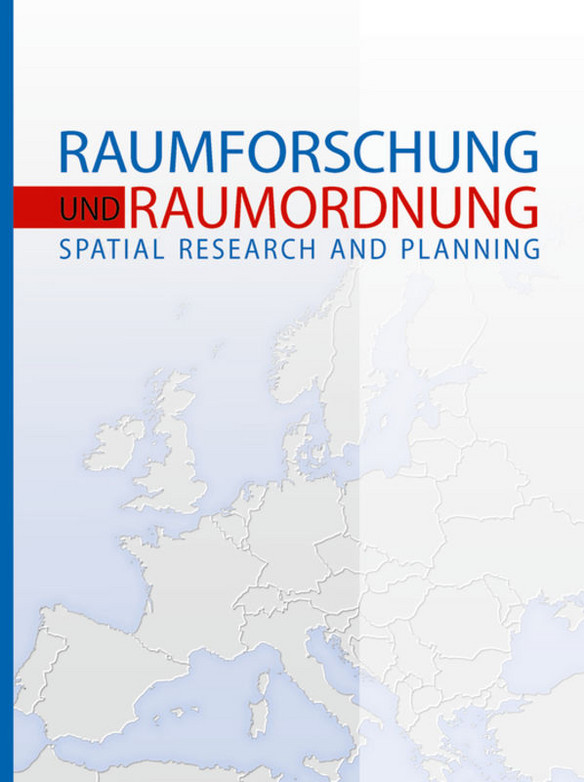Main Content
Special Issue of “Spatial Research and Planning”: Call for Papers on “Opportunities and Challenges in Rural Areas through Digitalisation”

With the corona pandemic at the latest, the importance of digital tools, the corresponding technical equipment and the ability to handle them has increased, also in rural areas. However, new solution models for life in rural areas that smart applications could enable have been experiencing for some time. A new special issue in the journal "Spatial research and Planning" aims to discuss and systematise the opportunities and challenges of digitalisation in rural areas.
There are initiatives that improve the mobility of the rural population through car-sharing apps; others that organise supply through delivery apps, thereby contributing to the networking of people and goods traffic and optimising transport chains and local supply. Village apps are used to organise various forms of neighbourhood assistance and to try out new ways of communication. Coworking spaces with office equipment and broadband connections are set up in villages to bring creative minds together and support new business ideas. Digital assistance systems make it possible to care for elderly rural residents in such a way that medical data can be transmitted to the doctor's prac-tice and neighbours can be alerted in an emergency. However, it seems necessary to develop specific rural ap-proaches to digital literacy. The training of local digital experts, who act as multipliers in their villages, is one example. At the same time, many rural areas are still struggling with problems of broadband access and mobile telephony equipment, because compared to (large) cities, the connection of regions with low population density is usually less attractive for telecommunication companies. This sometimes leads to experiences of de-synchronisation, frustration and the feeling of being left behind among rural residents.
Despite the many examples and the urgency of the topic, the academic discourse is still less developed than that in policy and practice, even though there is an increasing amount of literature on digitalisation in rural areas (e.g. Zerrer/Sept 2020; Lytras/Visvizi/Mudri 2019; Martin/Tulla 2019; Matern/Binder/Noack 2019; Levoli/Belliggiano/Marandola et al. 2019; Townsend/ Wallace/Fairhurst 2015). Conceptual approaches and the terminology used are still unsystematic. While smart city concepts are also viewed critically, be it because of their de-pendence on (globally operating) IT companies and a new influence of these companies on urban development (e.g. Bauriedl/Strüver 2018) or the “paternalistic and market-driven ideas of smart citizens” (Cardullo/Kitchin 2019), the debates on smart villages focus mainly on the opportunities of digitalisation or warn of a digital urban-rural divide.
Thus, previous research on rural digitalisation tends to be descriptive and pragmatic rather than analytical and theo-retical. At the same time, the theoretical concept of (digital) mediatisation is increasingly being used also in the spatial sciences to understand changes in spatial arrangements (Christmann/Singh/Stollmann et al. 2020), for exam-ple in the sense of a re-figuration of spaces through processes of digitalisation and mediatisation (Knoblauch/Löw 2020). Rural areas, on the other hand, have so far played hardly any role in these theoretical debates.
This Special Issue aims to bring together current theoretical and conceptual perspectives, methodological ap-proaches, case studies and empirical examples in order to discuss and systematise the opportunities and challenges of digitalisation in rural areas.
Potential topics may include (but are not limited to):
- Smart Countryside
- New (digital) actors and governance constellations in rural and regional development
- Rural coworking and remote working
- Digital multilocality: living and working between urban and rural
- Digital civic engagement in rural areas
- Services of general interest by means of digitalisation
- Digital planning and participation tools for rural development
- Strengthening digital literacy of elderly rural residents
- Consequences of the Corona pandemic for rural digitalization
Papers may be submitted as “article” or as “policy and practice perspective” (see “Instructions for Authors” of “Spatial Research and Planning”).
Planned publication: issue 2/2022
Abstract Submission: 30. November 2020
Abstract Decision: 18. December 2020
Article Submission: 30. April 2021
Planned Publication Issue: April 2022
Guest Editors: Ariane Sept und Gabriela Christmann (IRS)
Potential authors are requested to submit a structured abstract (with a working title, research question, original value, methodology and expected findings) of one page in length and send it by email to Ariane.Sept@leibniz-irs.de and Gabriela.Christmann@leibniz-irs.de
References
Bauriedl, S.; Strüver, A. (Hrsg.) (2018): Smart City. Kritische Perspektiven auf die Digitalisierung in Städten. Bielefeld.
Cardullo, P.; Kitchin, R. (2019): Being a ‘citizen’ in the smart city. Up and down the scaffold of smart citizen participa-tion in Dublin, Ireland. In: GeoJournal 84, 1, 1-13. doi: 10.1007/s10708-018-9845-8
Christmann, G.; Singh, A.; Stollmann, J.; Bernhardt, C. (2020): Visual Communication in Urban Design and Planning: The Impact of Mediatisation(s) on the Construction of Urban Futures. In: Urban Planning 5, 2, 1–9. doi: 10.17645/up.v5i2.3279.
Ievoli, C.; Belliggiano, A.; Marandola, D.; Milone, P. Ventura, F. (2019): Information and Communication Infrastruc-tures and New Business Models in Rural Areas. The Case of Molise Region in Italy. In: European Countryside 11, 4, 475-496. doi: 10.2478/euco-2019-0027
Knoblauch, H.; Löw, M. (2020): The Re-Figuration of Spaces and Refigured Modernity – Concept and Diagnosis. In: Historical Social Research 45, 2, 263-292. doi: 10.12759/HSR.45.2020.2.263-292
Lytras, M.; Visvizi, A.; Mudri, G. (Hrsg.) (2019): Smart Villages in the EU and beyond. Bingley.
Martin, A.V.; Tulla, A.F. (2019): Innovation, Spatial Loyalty, and ICTs as Locational Determinants of Rural Develop-ment in the Catalan Pyrenees. In: European Countryside 11, 4, 517-540. doi: 10.2478/euco-2019-0029
Matern, A.; Binder, J.; Noack, A. (2019): Smart regions. Insights from hybridization and peripheralization research. In: European Planning Studies 6, 1, 1-18. doi: 10.1080/09654313.2019.1703910
Townsend, L.; Wallace, C.; Fairhurst, G. (2015): ‘Stuck Out Here’. The Critical Role of Broadband for Remote Rural Places. In: Scottish Geographical Journal 131, 3-4, 171-180. doi: 10.1080/14702541.2014.978807
Zerrer, N.; Sept, A. (2020): Smart Villagers as Actors of Digital Social Innovation in Rural Areas: Analysis of Two Case Studies. In: Urban Planning 5, 4, 78-88. doi: 10.17645/up.v5i4.318

